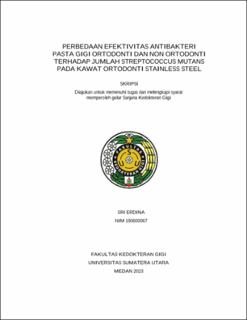| dc.description.abstract | Fixed orthodontic treatment can increase plaque accumulation. The components of the fixed appliance make it difficult for patient to clean the mouth effectively. Cariogenic bacteria in plaque can damage teeth by forming white spot lesion (WSL) which can lead to caries. The main bacteria that play a role in the formation of caries is Streptococcus mutans. Prevention of the accumulation of plaque bacteria, one of which is by brushing teeth with toothpaste. Now various toothpaste products are being developed, such as orthodontic toothpaste. This study aims to determine whether or not there is difference in the average numbers of Stretococcus mutans bacterial colonies on orthodontic wires soaked in orthodontic and non othodontic toothpaste. The research method is a laboratory experimental research with post test only control group design. The methods of the research started from making toothpaste solution. Then, antibacterial testing was carried out on the wire contaminated with Streptococcus mutans using the Total Plate Count (TPC) method with a positive control of chlorhexidine 0,2% and negative control of dimethyl sulfoxide (DMSO). The results of statistical test using One Way Anova showed there was a significant difference in the mean number of Streptococcus mutans bacteria in all treatments, orthodontic toothpaste, non orthodonti toothpaste, chlorhexidine 0,2%, and DMSO (p = 0,0001 < 0,05). LSD posthoc analysis showed that there was no significant difference in the mean number of Streptococcus mutans between groups of wires soaked in orthodontic and non orthodontic toothpaste (p = 0,0348 > 0,05). This research concludes that orthodontic toothpaste and non orthodontic toothpaste have the same antibacterial effectiveness against Streptococcus mutans. | en_US |

